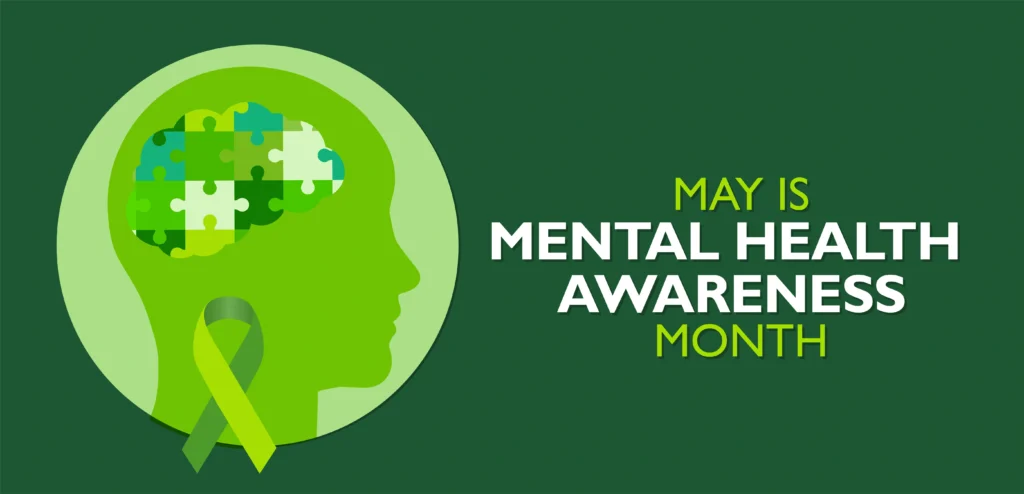Each May, we take note of Mental Health Awareness Month — usually by becoming more aware of what’s being done to destigmatize mental issues and treatment. But what about taking care of ourselves, and making sure that we’re supporting our own mental health?
That inward and outward focus has been a part of Mental Health Awareness Month since the observance began in the United States in 1949. By working toward community awareness of mental health challenges and concerns, as well as taking stock of our own mental health and wellness, we can ensure that the other 11 months of the year are better for ourselves and those around us alike.
National campaigns boost awareness, engagement
This year, the National Alliance on Mental Illness, or NAMI, has launched its More Than Enough campaign. According to NAMI, the campaign is “an opportunity for all of us to come together and remember the inherent value we each hold — no matter our diagnosis, appearance, socioeconomic status, background or ability. We want every person out there to know that if all you did was wake up today, that’s more than enough. No matter what, you are inherently worthy of more than enough life, love and healing. Showing up, just as you are, for yourself and the people around you is more than enough.”
The Substance Abuse and Mental Health Services Administration (SAMHSA) has recognized the monthly event for 20 years, also working to increase awareness about the vital role mental health plays in our overall health and well-being. Among the many tools it offers is information about the 988 toll-free dialing code, which Congress designated in 2020 to be operated through the National Suicide Prevention Lifeline.
The National Council for Mental Wellbeing has also curated an extensive set of publications, toolkits, original content, and other learning materials for people to obtain and use for themselves, and in their communities. The National Council also recommends a couple of quick and easy ways to engage and advocate:
- Contact your elected officials and urge them to address the behavioral health workforce shortage crisis.
- Sign up to receive updates and opportunities to advocate for better access to mental health and substance use care nationwide.
Resources for accessing care
Here are some resources the National Council recommends for finding and obtaining care, or finding out how to help those who need care:
- findtreatment.gov: The confidential and anonymous resource for people seeking treatment for mental and substance use disorders in the U.S. and its territories.
- 988 Suicide & Crisis Lifeline: The Lifeline provides 24/7, free and confidential support for people in distress, prevention and crisis resources for you or your loved ones, as well as best practices for professionals in the U.S.
- National Alliance on Mental Illness: A national organization that provides advocacy, education, support and public awareness so all individuals and families affected by mental illness can build better lives.
- The Trevor Project: 24/7 crisis support services to LGBTQ+ young people. Text, chat or call anytime to reach a trained counselor.
- 2022 Access to Care Survey: Explore barriers to care contributing to significant unmet need.
- Certified Community Behavioral Health Clinics (CCBHC): Learn about the innovative CCBHC model, its nationwide expansion and how CCBHCs are expanding access to care.
- Behavioral Health Workforce is a National Crisis: Immediate Policy Actions for States
- The Comprehensive Healthcare Integration (CHI) Framework
- Learn about the behavioral health workforce shortage and the need for policy solutions:
- New Study: Behavioral Health Workforce Shortage Will Negatively Impact Society
- Key Findings Infographic
- Shareable Social Media Graphics (.zip download)
- Learn more about substance use treatment:
- State Models for Addressing Opioid Use Disorders: Recovery Support in Integrated Care Settings
- Establishing Peer Support Services for Overdose Response: A Toolkit for Health Departments
- Harm Reduction Technical Assistance Stakeholder Analysis: A Summary of Findings
- Oral Health, Mental Health and Substance Use Treatment Toolkit
- Overdose Prevention in Community Corrections: An Environmental Scan
- Wellbeing Wednesdays – Episode 6: Federal Solutions to Overcome the Nation’s Overdose Crisis
- Wellbeing Wednesdays – Episode 8: Alcohol Use Disorder: Our Nation’s Hidden Epidemic
Here are some sobering statistics from the National Council for Mental Wellbeing:
- One in five adults (57.8 million adults) in the U.S. experienced mental illness in 2021.
- 46.3 million people aged 12 or over had a substance use disorder in 2021.
- 47.2% of U.S. adults with mental illness received treatment in 2021.
- 65.4% of U.S. adults with serious mental illness received treatment in 2021.
- 33.5% of U.S. adults with mental illness also experienced a substance use disorder in 2021 (19.4 million individuals).
- Suicide is the second leading cause of death among people aged 10-14 and the third leading cause of death among those aged 15-24 in the U.S.
- 46% of people who die by suicide had a diagnosed mental health condition.
- At least 4 million people in the U.S. provide care to an adult with a mental or emotional health issue.
- The average delay between symptom onset and treatment for mental illness is 11 years.
- 3 million Americans live in recovery after some form of substance use challenge.
- Three out of four people who experience addiction eventually recover.
It’s a lot of information to be sure — because mental health is a multifaceted, and growing, problem for everyone. Take some time this month to see what groups or agencies in your community might need some support. And, most importantly, take stock of your own mental health and get the services and support you need to take care of yourself.

